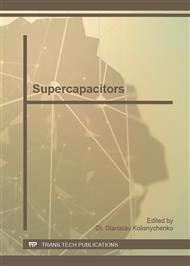[1]
J.P. Zheng, P.J. Cygan, T.R. Jow, Hydrous ruthenium oxide as an electrode material for electrochemical capacitors, J. Electrochem. Soc. 142 (1995) 2699-2703.
DOI: 10.1149/1.2050077
Google Scholar
[2]
T.R. Jow, J.P. Zheng, Electrochemical capacitors using hydrous ruthenium oxide and hydrogen inserted ruthenium oxide, J. Electrochem. Soc. 145 (1998) 49-52.
DOI: 10.1149/1.1838209
Google Scholar
[3]
V. Subramanian, H.W. Zhu, B.Q. Wei, Synthesis and electrochemical characterizations of amorphous manganese oxide and single walled carbon nanotube composites as supercapacitor electrode materials, Electrochem. Commun. 8 (2006) 827-832.
DOI: 10.1016/j.elecom.2006.02.027
Google Scholar
[4]
G.X. Wang, B.L. Zhang, Z.L. Yu, M.Z. Qu, Manganese oxide/MWNTs composite electrodes for supercapacitors, Solid State Ionics 176 (2005) 1169-1174.
DOI: 10.1016/j.ssi.2005.02.005
Google Scholar
[5]
Y.G. Wang, L. Yu, Y.Y. Xia, Electrochemical capacitance performance of hybrid supercapacitors based on Ni(OH)2/carbon nanotube composites and activated carbon, J. Electrochem. Soc. 153 (2006) A743-A748.
DOI: 10.1149/1.2171833
Google Scholar
[6]
H. Kim, B.N. Popov, Characterization of hydrous ruthenium oxide/carbon nanocomposite supercapacitors prepared by a colloidal method, J. Power Sources 104 (2002) 52-61.
DOI: 10.1016/s0378-7753(01)00903-x
Google Scholar
[7]
K.X. He, Q.F. Wu, X.G. Zhang, X.L. Wang, Electrodeposition of nickel and cobalt mixed oxide/carbon nanotube thin films and their charge storage properties, J. Electrochem. Soc. 153 (2006) A1568-A1574.
DOI: 10.1149/1.2208735
Google Scholar
[8]
Z. Fan, J.H. Chen, K.Z. Cui, F. Sun, Y. Xu, Y.F. Kuang, Preparation and capacitive properties of cobalt-nickel oxides/carbon nanotube composites, Electrochim. Acta 52 (2007) 2959-2965.
DOI: 10.1016/j.electacta.2006.09.029
Google Scholar
[9]
Y. Shan, L. Gao, Formation and characterization of multi-walled carbon nanotubes/Co3O4 nanocomposites for supercapacitors, Mater. Chem. Phys. 103 (2007) 206-210.
DOI: 10.1016/j.matchemphys.2007.02.038
Google Scholar
[10]
L.H. Su, X.G. Zhang, C.Z. Yuan, B. Gao, Symmetric self-hybrid supercapacitor consisting of multiwall carbon nanotubes and Co-Al layered double hydroxides, J. Electrochem. Soc. 155 (2008) A110-A114.
DOI: 10.1149/1.2806844
Google Scholar



